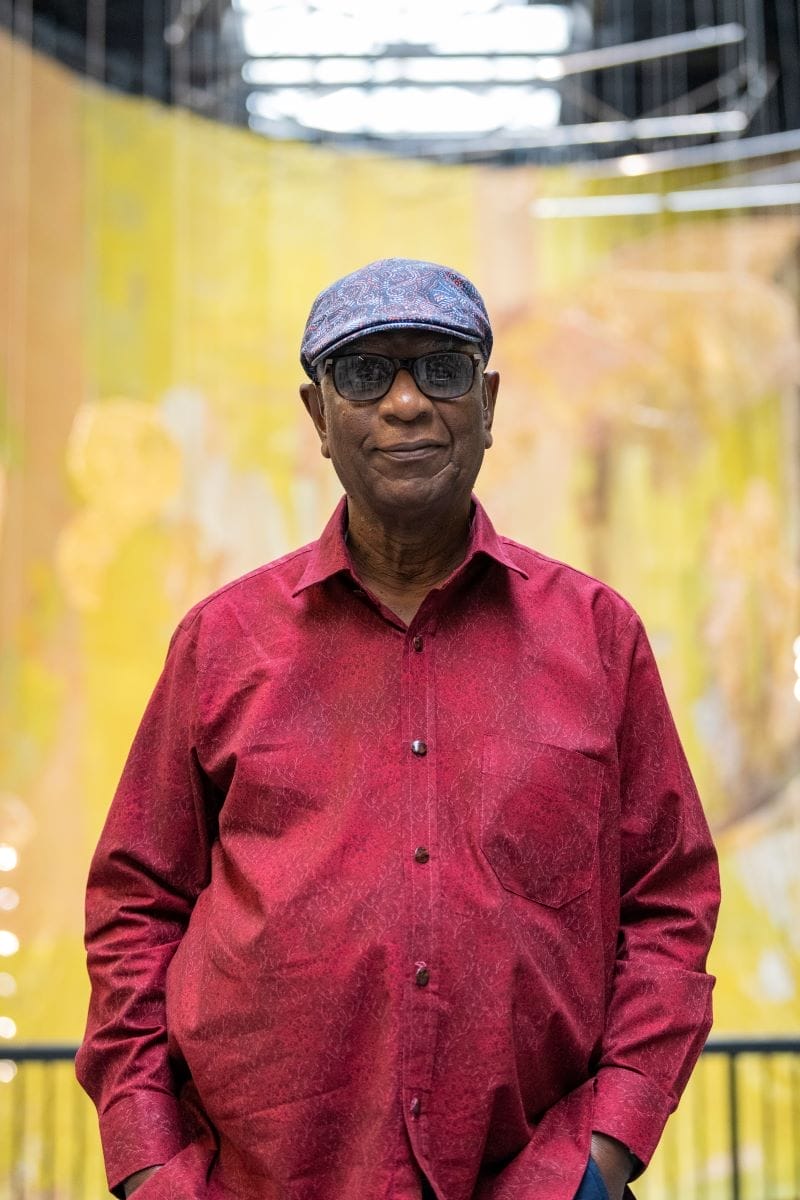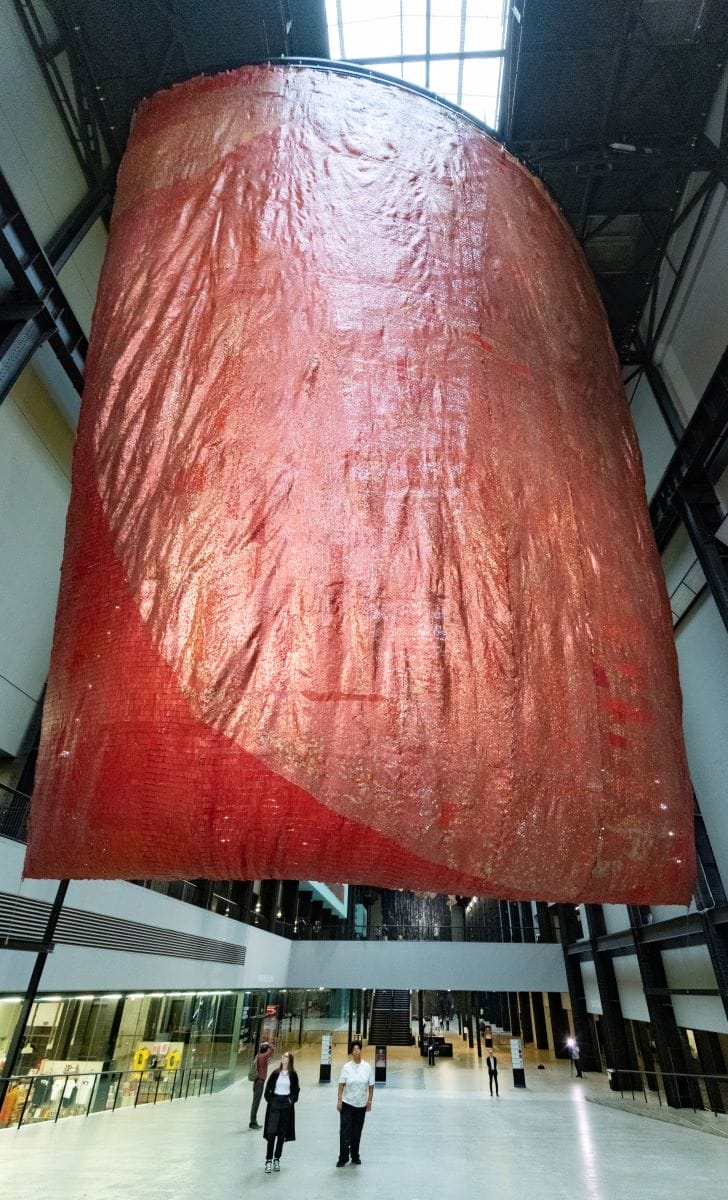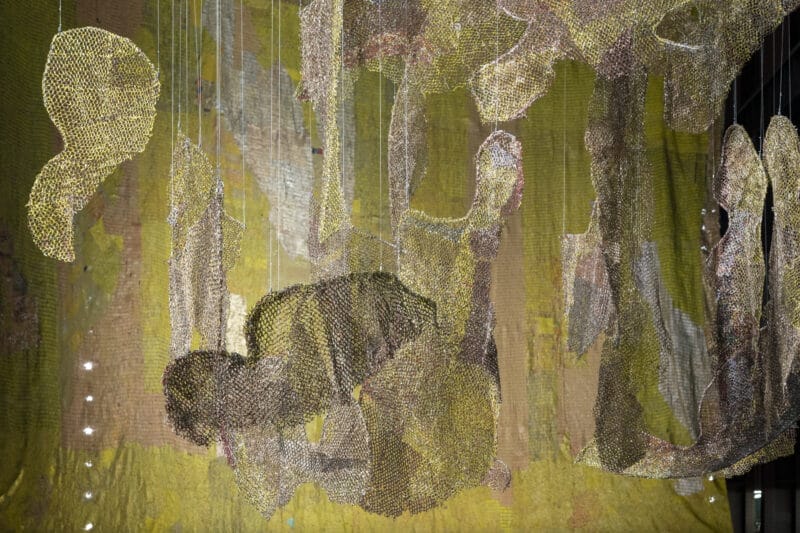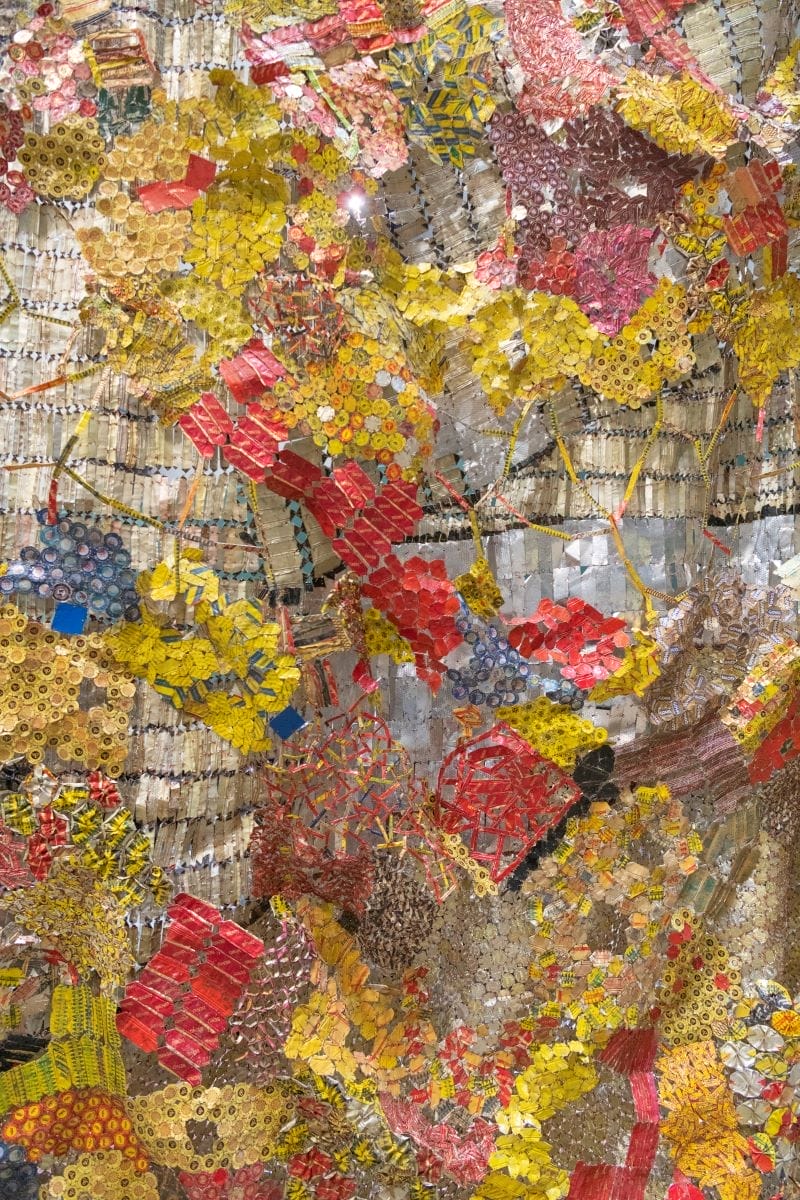Hyundai commission for TATE Modern in London, El Anatsui Behind the Red Moon
El Anatsui is arguably Africa’s most prominent living artist and one of the most critically acclaimed working internationally. His Hyundai commission for TATE Modern in London, Behind the Red Moon, opened to the public on 10th October 2023 until 14th April 2024.
He was born in 1944. He studied at a British-style art school, meaning it was a very western, formal tradition of painting. He was attracted to the progressive cultural politics that was promoted by mid-20th century Ghanian and African cultural nationalists, scholars, and artists of the independent era. Specifically prevailing ideologies and concepts of Pan-Africanism, exemplified in Ghana by Sankofa – an Akan term for ‘go back and pick’- suggested to him the importance of African artistic creative traditions as sources for his own experimental explorations. As the son of a master weaver, he expanded his compositions to other West African designs and sign systems, and alphabets, including Igbo, Ul, Efk Nsbidi, Barmun and Vai scripts. Now, bottle caps and their logos from gin, brandy and whisky have superseded them for the TATE work.

The Hyundai commission. Behind the Red Moon
The 8th Hyundai commission fills the daunting and vast industrial space of the TATE’s Turbine Hall. El Anatsui takes up the challenge to produce his largest and most complex work to date. He has draped the cavernous space in vast reams of fabric. With studios based in Tema, Ghana and Nsukka, Enugu Nigeria, thousands of flattened metal bottle tops, and fragments, have been stitched together into three expansive abstract compositions. Over 50 assistants from both studios helped resource discarded ‘rubbish,’ such as liquor bottle caps, cassava graters and newspaper printing plates, that are foundational to his practice.
“I saw the bottle tops as relating to the history of Africa in the sense that when the earliest group of Europeans came to trade, they brought along rum originally from the West Indies that went to Europe and finally to Africa as three legs of the triangular trip”, El Anatsui explained at the Tate press conference on 8th October 2023
This may partly explain why Behind the Red Moon is staged in three acts, or three legs of a journey.

Act 1: The Red Mood
The Turbine Hall reminds me of a ship. I was thinking about the motion and the ideas of the red sail The work addresses a history of encounter and the movement of people.
El Anatsui from the wall texts accompanying the commission.
The first journey is the beginning of a transatlantic trade route across the Atlantic Ocean. The first hanging, The Red Moon, is suspended high above the ramp of the Turbine Hall. It appears like a transparent sail, deep red in colour, almost caught mid-billow. Red liquor bottle tops form the outline of a blood moon. Within, the red colour, you can see some glistering gold fragments. Is it a lunar circle.? A blood moon produces in an eclipse, perhaps? The Turbine Hall is grey, dark, and rather dingy and many previous commissions have been overawed by it, but not here. Turnaround as you move past the red side of the moon and an intense yellow sun glows in front of you, shimmering in the light like a stained-glass window.

Act 11: The World
I use multiple elements to talk about the world not a world made up of just one culture, but a world shaped by all of us coming together.
El Anatsui from the wall texts accompanying the commission.
The second hanging, The World, is suspended near the bridge over the Turbine Hall. It appears to be a globe but from another point of view it suggests bodily forms, the coming together of people. Is this the middle passage of a journey, fraught with danger and trapped bodies on slave ships? It is a beautifully, executed, using thin bottle top seals wired together, the ‘singlet’, and similar stitching patterns developed by El Anatsui and his assistants. Whilst resembling an organic-like snake line, the work further evokes an ethereal like appearance of figures, caught in a semi-transparent net-like material. The emotional impact shifts from pleasure to a deeply troubling remainder, of enslaved people forced from their homes to the New World.

ACT 111: THE WALL
Tate &Lyle sugar was the only brand we used during my childhood on the Gold Coast. I came to understand that the sugar industry is from the transatlantic trade with the movement of goods and people. My idea is to play with all these elements.
El Anatsui from the wall texts accompanying the commission.
The final act and the final stage of the journey, there is a hanging, gigantic in scale and black in colour running from top to bottom of the space at the very end of the Turbine Hall. From a distance, the shiny material looks like it could be made up of cascading golden threads and precious jewels. Go nearer and bright sparks of colour, loosely fold into a drape comprised of a reused tangle of commercial labels and collected ‘rubbish’. Go even closer and you can read the labels from” brandy “to “goya beans.” Turn around to what appears to be the back of this draped wall and there is a mosaic of siler, shining threads composed of more commercial labels and twisted, entangled bottle caps.

As El Anatsui knows, his materials are imbued with power, not just many hands fuse the bottle tops together, but they have been handled by so many different people before that are collected and taken to his studios. What is disposable in the West, or as he prefers to call them, ‘discards’, have a long history of being reused in Ghanian and Nigerian culture. It is a reminder how ‘waste’ is a culturally constructed word.

The bottle caps- the main material El Anatsui has used for his TATE piece- is what he is best known for; he has been flattening, cutting, twisting, crushing, and stitching these fragments, with copper wire together since the 1990s. It is laborious and painstaking work. Fields of colour are created; the patterns are abstract, and they have no fixed form. There is a dynamic relationship of form and colour, painting, sculpture and textile, intricate making but on a gigantic scale. In his lecture and introduction to Behind the Red Moon, El Anatsui emphasises the fact that arrangement of the work ought to be different wherever they are reinstalled. In this commission, the aesthetic of the ‘unfixed form’ is powerfully exemplified. It also means that the metallic hangings can be folded to travel so that each new viewing evokes the changing histories of the artefacts he reposes. The work is not just mesmerizingly beautiful, it also bears witness to the human cost of history of trade, culture, and politics.

